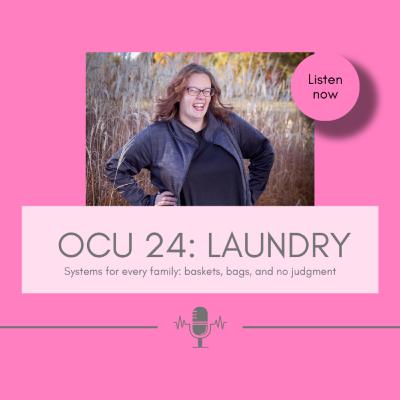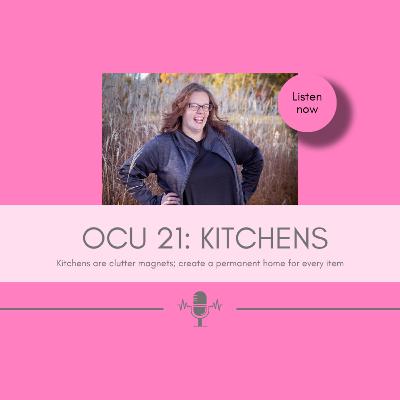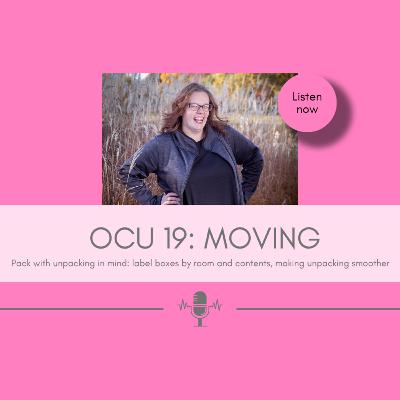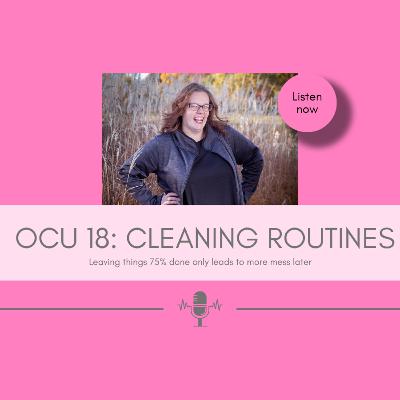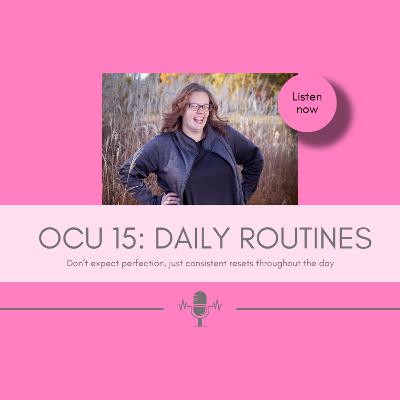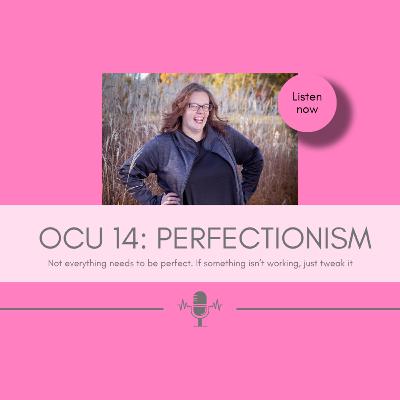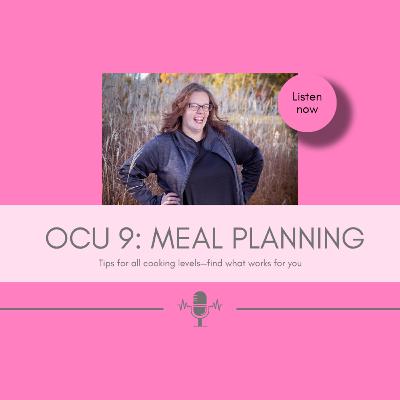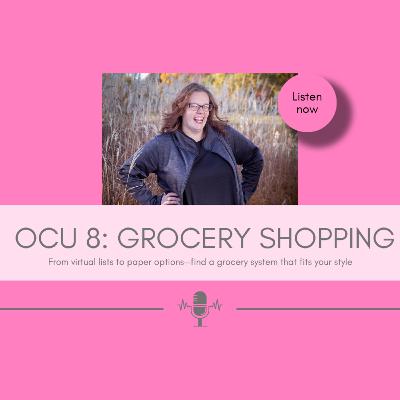Discover Organizing Confidence Unlimited
Organizing Confidence Unlimited

Organizing Confidence Unlimited
Author: Organizing CU
Subscribed: 9Played: 59Subscribe
Share
© Organizing CU
Description
Join Maggie from Organizing CU as she unpacks the mess and sorts through the stress—literally! Designed for busy moms who’ve had it with the mess and are craving a little peace and order, this fun and practical podcast delivers real-life tips, simple strategies, and a healthy dose of encouragement. With Maggie’s signature motto—reduce the mess, arrange the rest, maintain the calm—you’ll laugh, learn, and finally feel confident about getting (and staying!) organized. Because yes, you can find your keys and your sanity.
27 Episodes
Reverse
Feeling like your home is powered by pure chaos and caffeine? Good news—you don’t have to live in scramble mode! In this episode, we’re turning your family’s “Where’s that paper?!” panic into smooth, simple, you’ve-absolutely-got-this calm with a family command center that actually works.Think of it as your home’s mission control: calendars, meal plans, chores, reminders—everything in one happy little hub that keeps your days running easier (and keeps your brain from doing that endless mental juggling act).I’ll walk you through choosing the perfect spot, setting up the essentials, and creating a system that grows with your family—no Pinterest perfection required. Just simple steps, smart systems, and a whole lot of “wow, look at you crushing it!” energy.Because you can create a home that feels calm, organized, and totally doable… and this is your first step.Let’s turn that chaos into calm—one command center at a time. You’ve got this!Here is a list of options for your command center:On desk:Charging stationSmall tray for jewelry and/or keysNotepad and pensOn wall (can be clipboards, cork boards, photo frames, dry erase boards):ClockCalendar (week or month)Key hooksMenuGrocery listCleaning checklistArtwork/greeting card holderTo do listFiling system:Per personTo fileBills to paySchool stuffInvitationsPending fileCouponsTo readShredMailMagazinesReceipts
Traveling is a blast—until packing turns into chaos and your suitcase looks like a mini tornado hit it. In this episode, I’m diving into my Reduce, Arrange, Maintain method to help you travel lighter, stay organized, and actually enjoy your trip! From genius packing hacks and playlist ideas to kid-friendly travel tips and post-vacation routines, you’ll learn how to keep every adventure smooth, stress-free, and totally fun. ✈️ Let’s get organized and hit the road!
In this episode, we tackle the never-ending task of laundry and how to make it more manageable. Laundry can feel like a constant cycle, but with the right systems, it doesn't have to overwhelm you. The key to making it easier is to reduce the amount of clothing you have, arrange your laundry space efficiently, and maintain simple habits that keep it from piling up.I share practical tips like using mesh bags for kids' socks, buying lots of matching socks to skip the pairing game, and organizing laundry into baskets for towels, whites, and darks. We also discuss how to handle folding or hanging clothes, with some clients opting for baskets instead of dressers!The mindset shift is just as important: instead of striving for perfection, embrace the fact that laundry will never truly be “done,” and let go of the stress. It’s about finding what works for you and your family so you can keep up with the laundry without feeling buried under it.
In this episode, we dive into the do’s and don'ts of spring cleaning. While it’s tempting to tackle organization during your deep clean, I’m here to tell you—don’t! Focus on cleaning first, and save organizing for later. If you come across stray items while cleaning, toss them in a "lost and found" bin and keep going. The goal is to clean up forgotten spaces like mattresses, windows, and appliances without getting sidetracked.We also talk about creating a plan that works for you, whether you tackle it all at once or break it down over several days. A checklist, a timer, and a clear schedule can help you stay on track and avoid overwhelm. Remember, it’s about progress, not perfection—so embrace the small wins, and you'll see results.You can find my Spring cleaning list at organizingcu.com.
In this episode, we tackle the problem of permanent clutter—those items that start as temporary but end up lingering because we forget about them. We also revisit my organizing philosophy—reduce, arrange, maintain—focusing on how to clear out unnecessary items, assign homes for everything, and maintain order with simple daily routines. Whether it's donating items right away or scheduling time to reset your space, this episode will help you prevent clutter from taking over.
In this episode, we tackle one of the trickiest areas of the home to organize—the kitchen. As the central hub of most homes, it’s not only a space for cooking but often becomes the "drop zone" for everything from mail to bags to toys. With so many flat surfaces that attract clutter, keeping things organized requires intentional habits and a clear system for storage. We'll explore the steps for reducing, arranging, and maintaining a clutter-free kitchen, ensuring everything has a designated space.Whether you’re organizing in one big session or taking it step by step, this episode breaks down the process. From categorizing your kitchen items to applying the "20 dollars in 20 minutes" rule for things you don’t need, we'll help you streamline your kitchen's contents. Plus, we’ll dive into how to prioritize frequently used items while storing seasonal or seldom-used ones out of sight. By the end, you’ll have a kitchen that not only looks neat but functions efficiently for your daily needs.
In this episode, we dive into the emotional and practical sides of downsizing—whether it’s for a new chapter in life or just a change in space. Downsizing isn’t about losing—it’s about right-sizing, focusing on the essentials that truly make you feel at home. The key is shifting your mindset to what do I love instead of what do I get rid of, and taking it one step at a time. We’ll explore strategies to reduce clutter without overwhelm, how to involve your family in the process, and tips to make tough decisions, especially around sentimental items.If you're feeling stuck in the emotional weight of it all, don’t worry—there are simple, practical ways to lighten the load. From using a "turn and pack" method for the kitchen and closet to asking yourself powerful questions about your belongings, we’re breaking it down into manageable chunks. By focusing only on the items you truly love, you’ll not only simplify your space but also create a home that fits your new life perfectly.
Moving is overwhelming—packing every single thing feels like climbing a mountain. But instead of trying to conquer it all in one frantic weekend, think of it like reading a long book: tackle it in small chunks. Spend just 20 minutes or focus on one drawer at a time, and before you know it, you’ll be done without the stress meltdown.Use the trusty Reduce, Arrange, Maintain method: pare down what you really need, pack thoughtfully so unpacking makes sense, and keep everything organized throughout the process. Start early if you can—out-of-season clothes and toys your kids have outgrown are perfect first steps. And don’t forget to pack those “open me first” boxes with essentials like snacks, toiletries, and scissors—because you’ll definitely want easy access on day one at the new place!Pro tip: label everything clearly and put boxes in their new rooms right away. Future you will thank present you for the sanity-saving system!
Ready for some easy-peasy home hacks? First up: toss those random missing puzzle pieces or Barbie shoes into a “lost and found” bin instead of hunting down their forever homes mid-clean. Next, grab a laundry basket while tidying and collect stray items from other rooms—then put everything away after you finish that room. Boom, instant less-chaos magic!The secret sauce? Keep your cleaning habits real and doable—schedule daily and weekly chores that actually fit your life. And hey, if tackling the big stuff feels like climbing Everest, don’t sweat it—call in help! Staying organized is all about working with your habits, not against them. Easy wins, happy home!
Instead of trying to force yourself to change habits that keep your home disorganized, try changing the habitat—the places where you store things. For example, if you never hang your coat in the closet because it’s inconvenient, add a coat rack where it’s easier to toss it. Or if shoes always end up in the living room, move the shoe rack there instead of the back door.This idea fits with my organizing philosophy: after reducing clutter, arrange items where they naturally belong based on your habits. This makes maintaining organization easier because you’re working with how you actually live. Small changes like adding a basket for clothes on the bedroom floor can also help when you share your space with others. The key is to make simple, sustainable tweaks that suit your life—not drastic changes.
I’ve seen those baby gear checklists—and wow, they can be overwhelming! With lists ranging from 50 to over 100 items (counting groups of things like pajamas as just one), organizing all that baby stuff can feel impossible, especially since you won’t use everything right away.To make it manageable, I recommend setting up three main nursery stations: feeding, changing, and sleeping. Each station should be personalized to what works best for you and your baby, keeping all essentials within easy reach. For example, your feeding station might be in your bedroom or kitchen, while changing stations can be set up in multiple spots around the house for convenience.When organizing, maximize your vertical space—shelves, hanging organizers, and storage bins at eye level make it easier for you since your baby can’t reach yet. Also, think long term by choosing versatile items that grow with your child, like dressers that transition from changing tables to toy storage.With a little planning and flexible setups, you can keep your nursery organized and practical, even as your baby—and their needs—grow!
I recently spoke at a retreat about my organizing philosophy: Reduce, Arrange, Maintain—and how maintaining is the real key to staying organized long-term. While decluttering and setting up systems are important, keeping things tidy day-to-day is where most of us stumble.To help, I shared tips on building simple daily routines: planning your day the night before by checking your calendar, prepping meals, and tackling laundry; starting your mornings by jumping into chores to build momentum; and doing quick “resets” throughout the day—like making your bed, wiping counters, or tidying toy areas in short bursts.Using habits like the “one-touch” or “two-minute” rules can make small tasks manageable—fold laundry right away or quickly sweep crumbs before they pile up. And a family “command center” keeps important papers, grocery lists, and schedules all in one easy-to-find spot to reduce chaos.With consistent little habits, maintaining your organized home becomes doable—even with busy kids!
Let’s get real about perfectionism—because chasing perfect? It’s a wild goose chase! There’s no perfect family, business, or home, and that’s totally okay. Instead, let’s focus on getting just 1% better every day.Perfectionists, let go of the idea that you have to get it right the first time. Mistakes are part of the process and can be fixed! Stop comparing yourself to Pinterest-perfect homes and expert Instagrammers—they’ve put in years of work. Lower your standards where you can (hello, laundry folding shortcuts!), break big goals into small steps, and remember: imperfection can still be impactful.At the end of the day, it’s about progress, not perfection—and that’s way more satisfying anyway!
So, I finally cleaned my car—after weeks of ignoring those dusty dashboards and fingerprinted windows. I planned just 5 minutes, but boom… 16 minutes later, both cars were sparkling. Turns out, putting things off makes the task feel WAY bigger than it really is.To beat procrastination, just jump in and start—even if it’s not perfect. I've got some quick tips to help you conquer your pesky tasks you keep avoiding: break big tasks into small chunks, keep your to-do list simple, set a quick timer to get moving, limit phone distractions, and switch between tasks when you need a change.
With toys piling up—especially during the holidays—this episode covers how to Reduce, Arrange, and Maintain toy clutter.Reduce: Purge toys by focusing on what your kids love to keep or what they’ve used recently. Involve kids in the process and set a “one in, one out” rule to control new toys. Limit gifts from family to avoid overload.Arrange: For little kids, use toy rotations with a few bins to reduce overwhelm. For older kids, organize toys by type or create play zones to keep things tidy.Maintain: Label toy bins and encourage kids to clean up regularly. Use Amazon wish lists to control new toy purchases and make gift-giving easier.
Inspired by a listener’s request, this episode tackles the common challenge of garage clutter. Garages often become catch-alls for things we might need someday and tend to fill every inch of space, including inherited or leftover items.I share two main methods to organize your garage:All at once: Dedicate a full day or weekend to completely clear out, reduce, sort, reduce again (to remove duplicates), arrange, and maintain. (But don’t start with this huge project if you’re new to organizing!)Piecemeal: Break it down by categories (tools, sports gear, gardening, seasonal décor, etc.) or by physical sections (walls, middle space) and tackle one part at a time.Key tips:Use a “Reduce, Reduce, Arrange, Maintain” process to declutter twice—before and after grouping items.Ask yourself simple questions to decide what to keep, like “Have I used this in the past year?” or “Would I buy it again?”Arrange items by frequency of use (A = daily, B = often, C = rarely) and assign them to matching garage spaces (easy-to-reach spots for A items, high shelves for C).Maintain organization through regular resets, space limits (keep categories contained), questioning new items before bringing them in, and a “one in, one out” rule to avoid clutter buildup.With these steps, your garage can become a functional, manageable space—not a dreaded storage dump!
In this episode, I share how I got started in organizing—from giving a coworker pantry tips to launching my own business. I answer your most common questions, including:Will I make you get rid of stuff? (No—only if you want to!)When do I work? (Nights and weekends!)Is my home Pinterest-perfect? (Not at all—function comes first.)How far will I travel? (Local Champaign County, plus virtual consults.)Do I only work with hoarders? (No, any size project!)Can I help if you already have a plan? (Definitely—four hands are better than two!)Will I judge your messy house? (No, I need to see how you live!)Need just updates, not a full overhaul? (I got you—life changes and so do organizing needs.)Tune in for real talk about organizing, tailored to your life and your stuff.
If you’ve already heard “What’s for dinner?” today (maybe even before lunch!), you know mealtime can take over your day. In this episode, I’m sharing three flexible meal planning methods to fit your family’s schedule and cooking style:Plan every meal down to sidesShop seasonally and improviseUse themed nights for easy varietyPlus, I’ll share how I plan breakfasts, lunches, dinners, and leftovers to keep things running smoothly. Whether you’re new to meal planning or just need fresh ideas, this episode will help reduce dinner stress and keep your family fed happily!
This week, we’re zeroing in on grocery shopping—because meal plans are only as good as what’s in your cart.I’m sharing all my favorite tips for making your grocery runs smooth and stress-free: from why you absolutely need a grocery list (even if you think you don’t), to keeping a running list that everyone in the family can add to without bugging you. We talk virtual vs. paper lists, master lists for your weekly staples, and organizing your list by store layout so you’re not zig-zagging like a squirrel on caffeine.Plus, pro tip: bring a laundry basket to the store to haul those awkward heavy items in one trip (your fingers will thank you). It’s all about saving time, mental energy, and maybe a few gray hairs. Whether you’re a grocery store warrior or a delivery app devotee, there’s something here to make your shopping easier—and a little more fun.
Recorded during the 2020 pandemic, this episode offers practical tips to get your home ready for winter, with a few notes specific to this unusual year. From swapping out your summer clothes for cozy sweaters and making sure your winter gear is easy to grab, to prepping your outdoor spaces and car for freezing weather, I cover it all. I also share important reminders like unhooking hoses to avoid costly water damage. Plus, we talk about mental health during the long, dark winter months—how staying connected with loved ones and investing in quality winter gear can make a big difference. And finally, I dive into comfort food essentials to keep your kitchen stocked for warm, easy meals. Whether it’s any winter or this particular chilly season, these tips will help make life easier for your future self.




